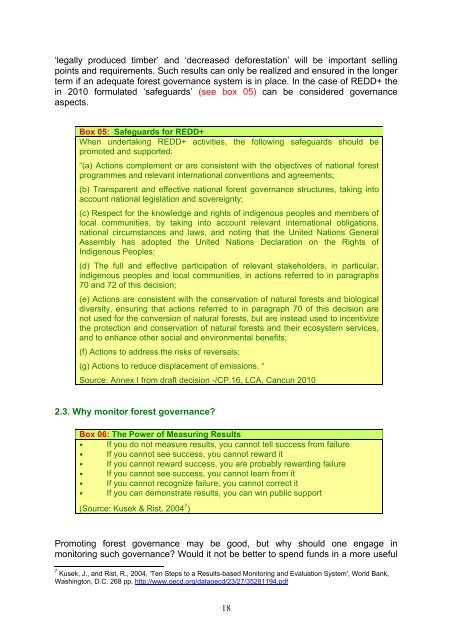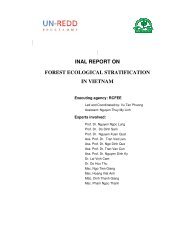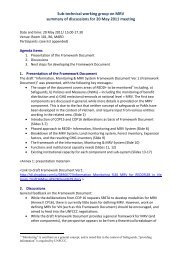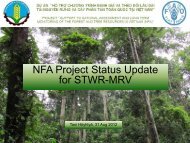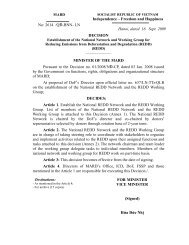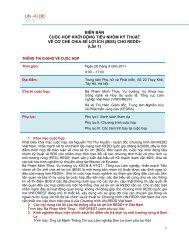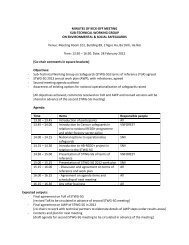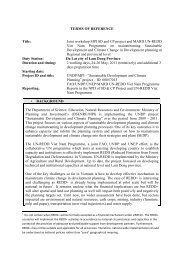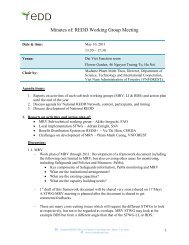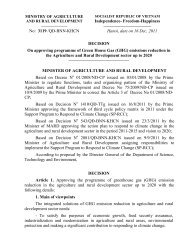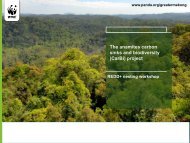FGM Workshop Background Paper - REDD - VietNam
FGM Workshop Background Paper - REDD - VietNam
FGM Workshop Background Paper - REDD - VietNam
Create successful ePaper yourself
Turn your PDF publications into a flip-book with our unique Google optimized e-Paper software.
‘legally produced timber’ and ‘decreased deforestation’ will be important selling<br />
points and requirements. Such results can only be realized and ensured in the longer<br />
term if an adequate forest governance system is in place. In the case of <strong>REDD</strong>+ the<br />
in 2010 formulated ‘safeguards’ (see box 05) can be considered governance<br />
aspects.<br />
Box 05: Safeguards for <strong>REDD</strong>+<br />
When undertaking <strong>REDD</strong>+ activities, the following safeguards should be<br />
promoted and supported:<br />
“(a) Actions complement or are consistent with the objectives of national forest<br />
programmes and relevant international conventions and agreements;<br />
(b) Transparent and effective national forest governance structures, taking into<br />
account national legislation and sovereignty;<br />
(c) Respect for the knowledge and rights of indigenous peoples and members of<br />
local communities, by taking into account relevant international obligations,<br />
national circumstances and laws, and noting that the United Nations General<br />
Assembly has adopted the United Nations Declaration on the Rights of<br />
Indigenous Peoples;<br />
(d) The full and effective participation of relevant stakeholders, in particular,<br />
indigenous peoples and local communities, in actions referred to in paragraphs<br />
70 and 72 of this decision;<br />
(e) Actions are consistent with the conservation of natural forests and biological<br />
diversity, ensuring that actions referred to in paragraph 70 of this decision are<br />
not used for the conversion of natural forests, but are instead used to incentivize<br />
the protection and conservation of natural forests and their ecosystem services,<br />
and to enhance other social and environmental benefits;<br />
(f) Actions to address the risks of reversals;<br />
(g) Actions to reduce displacement of emissions. “<br />
Source: Annex I from draft decision -/CP.16, LCA, Cancun 2010<br />
2.3. Why monitor forest governance?<br />
Box 06: The Power of Measuring Results<br />
• If you do not measure results, you cannot tell success from failure<br />
• If you cannot see success, you cannot reward it<br />
• If you cannot reward success, you are probably rewarding failure<br />
• If you cannot see success, you cannot learn from it<br />
• If you cannot recognize failure, you cannot correct it<br />
• If you can demonstrate results, you can win public support<br />
(Source: Kusek & Rist, 2004 7 )<br />
Promoting forest governance may be good, but why should one engage in<br />
monitoring such governance? Would it not be better to spend funds in a more useful<br />
7 Kusek, J., and Rist, R., 2004, 'Ten Steps to a Results-based Monitoring and Evaluation System', World Bank,<br />
Washington, D.C. 268 pp. http://www.oecd.org/dataoecd/23/27/35281194.pdf<br />
18


